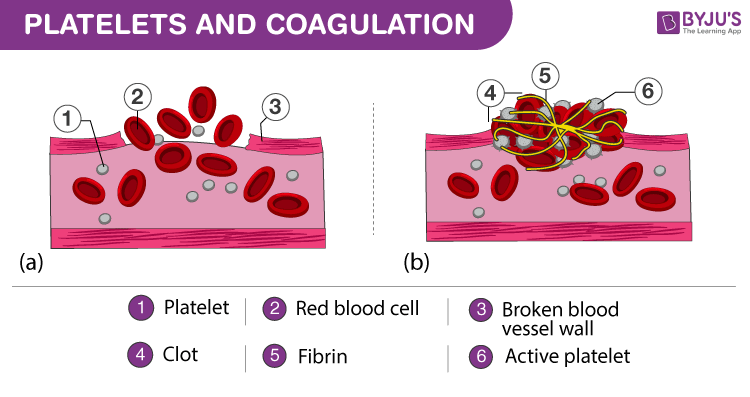“Platelets are minute fragments of blood cells that help in the formation of clots in the body to stop bleeding.”
Any damage in the blood vessels sends signals to the platelets. The platelets rush to the site of damage and form clots to repair the damage.
The activated platelets stick together to form a platelet plug which in turn activates the coagulation factor. Vitamin K is beneficial for the proper functioning of the coagulation factor.
Let us have an overview of platelets and coagulation.
Also Read: Blood Coagulation

Platelets and Coagulation
The larger cells called megakaryocytes are disintegrated to form thrombocytes. Each megakaryocyte contains 2000-3000 platelets. Each platelet contains several vesicles but no nucleus.
The endothelial cells present on the inner surface of blood vessels. When the endothelial layer is injured, it exposes collagen and all other factors that help in blood clotting. These factors attract platelets to the wounded site.
The activated platelets clump together to form a platelet plug, releasing their contents. These contents activate other platelets and interact with other coagulation factors.
“Coagulating factors are proteins present in blood plasma that helps in converting fibrinogen to fibrin, that strengthens platelet plug.”
Thus the platelets help in blood coagulation.
Hemostasis
“Hemostasis is a physiological defensive reaction to an injury or a cut that seals the blood vessels and thus helps in healing.”
Mainly platelets, endothelial cells of blood vessels, and blood proteins are responsible for hemostasis. Hemostatic mechanism proceeds in the following series of steps:
- Changes in blood vessel cells
- Blood clot formation
- Platelet plug formation
Stages of Hemostasis
Hemostasis takes place in two stages:
Primary Hemostasis
It is caused when bleeding ceases or gets reduced by contraction of the blood vessels, and thrombin signals for platelet assembly and forms a loose platelet plug.
Secondary Hemostasis
It includes the action of blood proteins and coagulation factors in a sequence to reinforce the platelet plug and marks the onset of the healing process. Blood coagulation is provoked by the extrinsic pathway i.e. tissue damage, but the intrinsic pathway (internal messengers) intensifies the coagulation.
Coagulation of blood is a lengthy process occurring within a few minutes where numerous coagulation factors come into play.
Also Read: Difference between RBC and WBC
To know more about the platelets, coagulation and hemostasis, keep visiting BYJU’S website or download BYJU’S app.

Comments